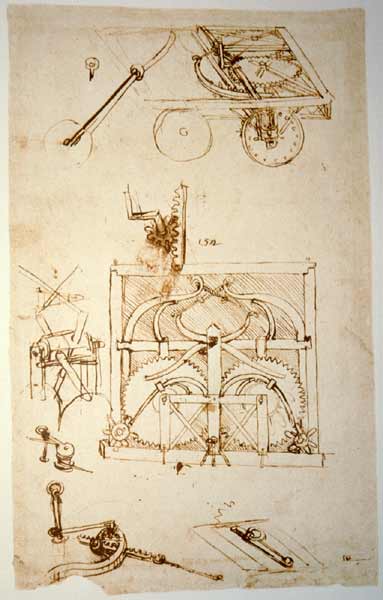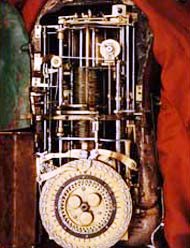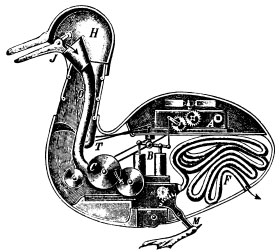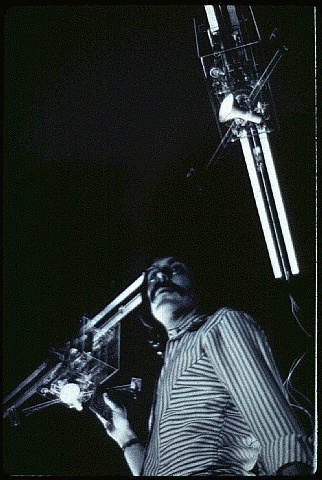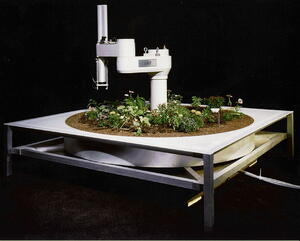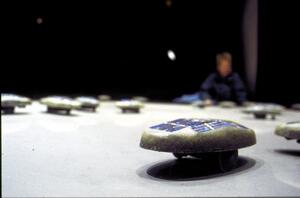An Art Robots Timeline
See also Category Robotics and Project Lirec
Era of magic, weights and pulleys
The earliest instances of robotics all seem to have been created for artistic reasons, and were usually in the form of automatons, generally for theatrical and musical use.
Third century B.C.
Mechanical Orchestra & Toys: Ancient China, Han Dynasty.
http://en.wikipedia.org/wiki/King_Mu_of_ZhouThe king stared at the figure in astonishment. It walked with rapid strides, moving its head up and down, so that anyone would have taken it for a live human being. The artificer touched its chin, and it began singing, perfectly in tune. He touched its hand, and it began posturing, keeping perfect time…As the performance was drawing to an end, the robot winked its eye and made advances to the ladies in attendance, whereupon the king became incensed and would have had Yen Shih [Yan Shi] executed on the spot had not the latter, in mortal fear, instantly taken the robot to pieces to let him see what it really was. And, indeed, it turned out to be only a construction of leather, wood, glue and lacquer, variously coloured white, black, red and blue. Examining it closely, the king found all the internal organs complete—liver, gall, heart, lungs, spleen, kidneys, stomach and intestines; and over these again, muscles, bones and limbs with their joints, skin, teeth and hair, all of them artificial…The king tried the effect of taking away the heart, and found that the mouth could no longer speak; he took away the liver and the eyes could no longer see; he took away the kidneys and the legs lost their power of locomotion. The king was delighted.
More cases of ancient Chinese automatons listed here: http://clearharmony.net/articles/200407/20619.html
1st Century B.C.
Philo of Byzantium: Wrote Mechanike syntaxis (Compendium of Mechanics), which contained a chapter on Automatiopoeica - mechanical toys and diversions. http://en.wikipedia.org/wiki/Philo_of_Byzantium
1st Century A.D.
Hero of Alexandria (known as Michanikos, the Machine Man) wrote “On Automatic Theaters, On Pneumatics, and on Mechanics, probably a continuation of Philo of Byzantium's work, and constructed an automaton theatre which was powered by weights and slowly emptying containers of sand. His theatre was capable of portraying different scenes of the play, each with it's own seemingly self powered characters.
Scene 1 from Nauplius, on Hero's Automaton Theater
Petronius the Roman writer, refers to a silver doll which could move like a human being.
13th Century
Al Jazari wrote “The Book of Knowledge of Ingenious Mechanical Devices” in 1206.
Villard de Honnecourt Surviving drawings of his work include an angel automaton which was designed to revolve once per day, in order that it's finger would always be pointing in the direction of the sun.
Johannes Müller von Königsberg or “Regiomontanus” as he prefered to be known (and has a crater on the moon named after him) is recorded as having built two automata:
- A Wooden eagle which “flew forth” out of Nuremberg and met Emperor Maximilian, saluted him and flew home.
- An iron fly:
Once, as this artist, more with mirth than meat; Feasted some friends whom he esteemed great, Forth from his hand an Iron Fly flew out; Which having flown a perfect round about, With weary wings returned to his master, And as judicious on his arm he plac'd her. Oh! wit divine, that in the narrow womb Of a small Fly could find sufficient room For all those springs, wheels, counterpoise, and chains, Which stood instead of life, and blood, and veins.
From “A Library Of Wonders And Curiosities Found In Nature And Art, Science And Literature” by I. Platt: http://chestofbooks.com/reference/A-Library-Of-Wonders-And-Curiosities/A-Wooden-Eagle-and-an-Iron-Fly.html
Era of the coiled spring and clockwork
15th Century
Prague Orloj Astronomical clock: Built by clockmaker Mikuláš of Kadaň and Jan Šindel in 1410: http://en.wikipedia.org/wiki/Prague_Astronomical_Clock
Leonardo da Vinci designed many automata, including a Lion and a Knight. His programmable cart was the basis for these machines, and has been built in modern times from his plans by Mark Rosheim.
Leonardo's programmable cart.
16th Century
Pierre Jaquet-Droz Built intricate automata which survive today, The Writer (made of 6000 pieces), The Musician (2500 pieces) and The Draughtsman (2000 pieces). These can now be seen at the Museum of Art and History, Neuchatel, Switzerland.
The “innards” of The Writer
18th Century
Jacques de Vaucanson (1709) Built robots to serve dinner to politicians. His most famous work is the Digesting Duck:
Voltaire wrote that “without […] the duck of Vaucanson, you have nothing to remind you of the glory of France.” (”Sans…le canard de Vaucanson vous n’auriez rien qui fit ressouvenir de la gloire de la France.”) This is often misquoted as “Without the shitting duck, we would have nothing to remind us of the glory of France.”
Era of electricity
19th Century
The Robot Boat of Nikola Tesla In 1898. “When first shown… it created a sensation such as no other invention of mine has ever produced.”
20th/21st Century
Robots as art
- 1964 Nam June Paik and Shuya Abe Robot K-456 “As Paik guided it through the streets, K-456 played a recording of John F. Kennedy's inaugural address and excreted beans.” Later hit by a car in an artistic statement/prank by Paik on technologies out of control.
- 1966 Tom Shannon's Squat - using an electrified plant as a sensor, squat detected human presence and indicated this by changing it's behaviour.
- 1970 Senster by Edward Ihnatowicz, 15 feet long sound reactive sculpture commissioned by Phillips for exhibition in Eindhoven. Senster was interactive with it's audience, and was programmed to be attracted to quiet viewers, while moving away from louder agitated viewers. Allegedly the first computer controlled artwork, employing the use of a digital Philips minicomputer in order to process sound.
- 1976 Norman White's Menage, a homage to W. Grey Walter, an early pioneer in brain research and the artificial modelling of organic behavior - Menage consisted of five light reactive robots, some on ceiling tracks which locked onto each other's light sources and exhibited complex behaviour.
Norman's core art-beliefs:
- Art should concern itself as much with behavior as it does with appearance.
- Some of the best art happens when behavior and appearance are completely at odds with each other.
- Economy of means is a critical part of aesthetics.
- Art functions best, and is most needed, outside of galleries and museums.
- James Seawright created many electronic interactive art installations from the late 60's onwards which incorporated robotic elements.
- 1995 Ken Goldberg, Joseph Santarromana, George Bekey, Steven Gentner, Rosemary Morris, Carl Sutter, and Jeff Wiegley, Telegarden - a robot controlled by remote operators to create and maintain a communal garden.
- 1996 Petit Mal by Simon Penny
The goal of Petit Mal is to produce a robotic artwork which is truly autonomous; which is nimble and has “charm”; that senses and explores architectural space and that pursues and reacts to people; that gives the impression of intelligence and has behavior which is neither anthropomorphic nor zoomorphic, but which is unique to its physical and electronic nature.
- Chico MacMurtrie including inflatable robots!
- Ken Rinaldo curator/designed of The Autotelematic Spider Bots:
The Autotelematic Spider Bots 2006, is a new artificial life robotic installation. It consists of 10 spider-like sculptures that interact with the public in real-time and self-modify their behaviors, based on their interaction with the viewer, themselves, their environment and their food source.
- Martin Spanjaard inventor of a ballbot called Adelbrecht
- Ulrike Gabriel Terrain_01,
Two users sit facing each other, wearing interfaces of a brainwave detection system on their heads. Between the two is a round glass table where the solar robots live. The brain waves of the users are measured, analyzed and compared. The alteration in wave patterns determine the speed, behavior and the terrain areas of activity. The movement of the robots will be lively if the users minds are calm. Due to the different combinations of users and their inner response to each other, varying light patterns from top-down and bottom-up affect the terrain. The robot population begins to move in significant patterns of motion over the changing terrain area. The patterns are the interpretation of the two users” synergy, embodying subliminal tendencies: the more closely the brain wave frequencies of the users resemble each other, the more homogeneously the robot population moves, attaining a fluidity of motion and behavior over the entire robot terrain.
- Nicolas Schöffer cybernetic art through painting, sculpture and town planning.
- David Karave believes that robots are the next step in art history:
- Early painting (1 dimensional rendition)
- Modern painting (2 dimensional rendition)
- Sculpture (3 dimensional rendition)
- Photograph (2 dimensional representation)
- Moving image (2 dimensional rendition/representation in time)
- Robotics (3 dimensional rendition in time)
- Cinematic Theatre/Holograms/genetic art (3 dimensional representation in time)
- Yves Amu Klein wearable robots, parallels with Lirec research:
Imagine being able to wear bracelets, earrings, badges, and necklaces that develop an intimate relationship with you, reacting to you in many different ways. This is the goal of Living Jewelry. Each piece of Living Jewelry can learn to recognize different qualities in your voice and movement, discovering more of your personality and behavior.
- Driessens & Verstappen including a tickle robot
Robots as theatre/dance
See also movement behaviour animation and robots
- Survival Research Labs Industrial scale robotic performance, with lots of explosions.
- Margot Apostolos A choreographer for robots
Robot generated art
- Harold Cohen's automatic artist experiments: http://crca.ucsd.edu/~hcohen/
- Robot Coloring Pages: http://www.coloringpages4kidz.com/
Robot art events
- ArtBots - A talent show for robots.
Articles on robot art
- Foundation and development of robotic art Art Journal 1997 Eduardo Kac.
- Robotic Art Chronology by Eduardo Kac.

